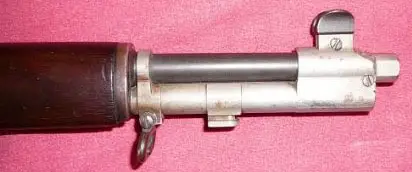|
Gas Trap: The Earliest M1 Garand Rifle By David Tong  My occasional duties at a local gun shop in my hometown, Albany Guns, is fraught with monetary danger, in that a seemingly endless supply of oddball relics and historical minutiae wander in the door. The owner, Mr. Nick Russell, loves to try to stump me by holding something up and asking me what it is, or how to take it apart, and a goodly percentage of the time I can account for the former, if not so reliably the latter. Such was the case not long ago when I walked in to do some work rehabbing neglected guns, when he pointed to a soft rifle case on the counter and asked me to take a look at it, probably to see my reaction. The first thing I saw was a stamped, checkered steel buttplate, which looked U.S. military but lacked the usual latching door for the sectional cleaning rod and accoutrements in the stock. As soon as I grabbed the wrist of the rifle I knew, “Garand.” As the muzzle cleared the case my eyes got real big. As many readers may know, ex-pat Canadian turned American John Cantius Garand developed a new semi-automatic rifle around 1932. This was at the U.S. Army's Springfield Armory and Garand's rifle was adopted in 1936, as “U.S, Rifle, Caliber .30, M1.” All the regular features of the rifle appeared normal, save for the gas cylinder under the barrel’s muzzle, as it appeared to be made of stainless steel and left in the white. This made the very early M1's look quite different from the majority of the over six million M1s made. Nick asked, “What do you think it is?,” and I answered, “Oh God, I think it’s a gas trap Garand!.” He shook his head and smiled. I knew full well that being able to handle and carefully disassemble it for photographic purposes would likely be a once in a lifetime opportunity, as these rifles are exceedingly rare in this condition and worth in the mid-five-figures. The official designation for the original prototype was “M1E4,” as best I can determine. The gas trap system is essentially an expansion chamber, which diverted gas to the front of the operating rod and its piston “tip.” This assembly acts as an 18” long moving gas piston that delivers, via an angled bolt lug cam track, rotational impetus to the bolt and provides both locking and unlocking movement. The expansion system proved less than reliable, so it was replaced by a conventional 90-degree drilled hole near the muzzle. Variations of the drilled hole gas port driving a piston power the vast majority of gas-operated long arms used today.  As the Army prepared for war, gas trap M1s were rapidly converted to the simpler system and knowledgeable authorities state that pre-1939 gas trap M1s are very rare in unmodified form. This particular example had many “-1” numbers on its small parts, all produced by Springfield on this 5-digit serial numbered rifle, indicating first variation parts. The walnut stock had the usual P in a circle under the wrist behind the trigger, indicating military acceptance. As noted above, the buttplate was different than the later issue item and the gas trap cylinder and front sight assembly differs in appearance as well. The entire rifle was in 98% or better condition, including the stock. It belonged to one of Nick’s good friends, who purchased it for several thousand dollars. My understanding is that it sold for over $40,000 at auction. Fortunately for me, I couldn’t get within spitting distance of that sum, so my wallet was safe (this time). The M1 provided sterling service for U.S. troops during WWII. It completely outclassed the manually-operated turnbolt rifles of our enemies. It was particularly well adapted to a war of rapid mechanized movement and combined-arms fire, started by the British in 1918 and perfected by the German Blitzkrieg of 1939 and the early 1940's. Everyone has heard George Patton’s famous quote about the M1 being, “the greatest battle implement ever devised.” The gas trap was the first step in the M1 rifle’s long history. |